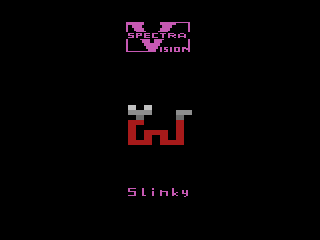Retro Replay Review
Gameplay
Tape Worm places you in control of Slinky, a growing tapeworm whose only goal is to clear the bean patch of its colorful kernels. The core mechanic revolves around collecting beans that randomly appear in the field, with each bean consumed extending your length and inching you closer to level completion. However, this simple concept hides a web of pressing threats: a relentless beetle scuttles along the bottom edge, and if it reaches the far right before you finish off the beans, not only do you miss your chance, but the patch spawns two extra beans and your bean count climbs by two.
Adding to the tension are two dynamic hazards—Beeky the bird and Spanky the spider—who swoop or crawl across the patch in later stages. Contact with your head means losing a life, as does a collision with your own body, stray obstacles, or the patch’s boundaries. These intertwined dangers make predator and self-collision equally menacing, forcing you to plan routes carefully while staying constantly alert.
Levels increase in both speed and complexity as you progress through five stages themed after different fruits—Apple, Orange, Grape, Strawberry, and Banana—each offering higher point values per bean and a bonus prize. The night stage introduces limited vision: after eating a bean, the field illuminates for two seconds, with extra flashes available at the cost of beans. This adds a strategic resource-management layer, as you must decide whether to spend precious beans for sight or press on blind.
Lives are represented by worms, and every 1,000 points earns you an extra Slinky—up to a maximum of four in reserve. This bonus system rewards risk-taking, as chaining bean collections quickly can boost your score and bank you extra attempts. Whether you’re edging around a corner to nab a stray bean or deciding when to risk a night-vision flash, Tape Worm’s gameplay loop is deceptively straightforward yet deeply engaging.
Graphics
Visually, Tape Worm embraces a clean, retro aesthetic that evokes the golden age of arcade gaming. The bean patch is rendered as a simple grid, with brightly colored beans popping against a darker background. Each fruit-themed level adds subtle palette shifts—reds for strawberries, deep purples for grapes—that help distinguish stages at a glance and celebrate the game’s thematic progression.
Character sprites are minimalist yet expressive. Slinky’s head is marked by a distinct yellow square, making it easy to track even as your length snakes around the screen. The beetle, bird, and spider are small but animated enough to inject personality: the beetle scuttles in a steady rhythm, Beeky flaps overhead, and Spanky crawls with a skittering motion. Despite limited detail, these critters are instantly recognizable and heighten the feeling of a living, hostile environment.
The night stage showcases a clever use of lighting effects for its era. Darkness engulfs most of the screen, save for a brief halo around Slinky when you consume a bean or trigger the fire button. This temporary illumination pops against the black expanse and serves both functional and aesthetic roles, reinforcing the suspense of blind navigation. Obstacle blocks, introduced in later levels, are clearly delineated yet blend seamlessly into the environment, preserving visual clarity even during hectic play.
While Tape Worm doesn’t rely on flashy transitions or high-fidelity art, its straightforward visuals remain strikingly effective. The simple color coding, readable sprites, and occasional flashing effects combine to form an interface that’s both retro-charming and perfectly suited to the game’s tight mechanics.
Story
At its heart, Tape Worm features a minimalist narrative that serves as charming context for the arcade action. You play as Slinky, a tapeworm with an insatiable appetite for beans in a magical garden of fruit-themed patches. There’s no deep plot twist or heavy dialogue, but the premise is whimsical enough to give purpose to your wriggling quest.
Each level’s fruit motif adds a playful layer to the story. Clearing the apples feels humble and straightforward, while progressing to bananas signifies a bolder challenge and greater reward. The repeated cycle of growth—eating beans, elongating across the patch, evading predators—echoes classic tales of survival and adaptation, albeit in a very lighthearted package.
Though Tape Worm doesn’t deliver an epic storyline, it thrives on emergent narratives. Players often recount slippery escapes from Spanky’s fangs or nail-biting finishes as the beetle closes in. These self-generated moments of tension and triumph build a shared lore among fans, keeping the simple plot alive through the excitement of gameplay.
Ultimately, the story functions as a whimsical backdrop rather than the main attraction. It invites you into a world where a tapeworm’s bean banquet becomes an arcade odyssey—proof that a modest narrative, when paired with tight mechanics, can still leave a lasting impression.
Overall Experience
Tape Worm delivers a satisfyingly addictive arcade experience that balances simplicity with strategic depth. Its growth-and-avoidance gameplay loop is easy to learn but difficult to master, making it accessible for newcomers while offering veterans plenty of reasons to return. The incremental difficulty curve, punctuated by new hazards and the resource-based night stage, ensures that each playthrough feels fresh.
Sound design is functional and nostalgic, featuring upbeat chiptune jingles and concise effect blips for bean collection and collisions. While not revolutionary, the audio cues provide essential feedback and complement the retro visuals, rounding out the sensory package without overstaying their welcome.
The game’s scoring system—rewarding 5 to 25 points per bean and bonus fruits worth up to 250 points—encourages risk-and-reward decisions. Chasing high scores feels gratifying, especially when you see extra worms piling up in reserve. Multiplayer might be absent, but Tape Worm’s leaderboard potential and instant restarts cultivate a personal battle against the clock and your own best efforts.
In summary, Tape Worm is a compelling title for anyone who appreciates crisp arcade mechanics, charming retro aesthetics, and bite-sized challenges that build into longer sessions. Whether you’re a fan of classic Snake variants or simply seeking a quick but engrossing diversion, Slinky’s bean-eating adventure offers hours of wiggle-filled fun.
 Retro Replay Retro Replay gaming reviews, news, emulation, geek stuff and more!
Retro Replay Retro Replay gaming reviews, news, emulation, geek stuff and more!








Reviews
There are no reviews yet.